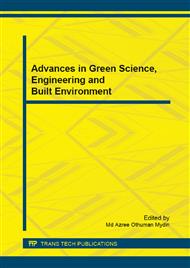p.213
p.217
p.221
p.226
p.230
p.234
p.238
p.242
p.246
Thermal Properties of Foamed Concrete with Various Densities and Additives at Ambient Temperature
Abstract:
This paper will focus on experimental investigation to observe the effects of different densities and additives on the thermal properties of foamed concrete by means of Hot Disk Thermal Constant Analyzer, so as to obtain a few fundamental thermal properties for prediction of its fire resistance performance. For this study, samples of three different densities of 700kg/m3, 1000kg/m3 and 1400kg/m3 and various additives were investigated to study the effects of densities and additives on the thermal properties of foamed concrete. The additives used in this research were pulverized fuel ash (PFA), silica fume, palm oil fuel ash (POFA), wood ash, polypropylene fibre, steel fibre and coir fibre. It should be pointed out that the lowest density of foamed concrete (700kg/m3) has provided best thermal insulation properties due to large amount of pores and high percentage of air entrapped because air is poorest conductor of heat than solid and liquid. Also, foamed concrete with coir fibre achieved lowest thermal conductivity because it possess high heat resistance due to its large percentage of hemicellulose and lignin and exhibited high heat capacity as well due to the formation of uniform pores and voids in foamed concrete.
Info:
Periodical:
Pages:
230-233
Citation:
Online since:
March 2015
Price:
Сopyright:
© 2015 Trans Tech Publications Ltd. All Rights Reserved
Share:
Citation:


